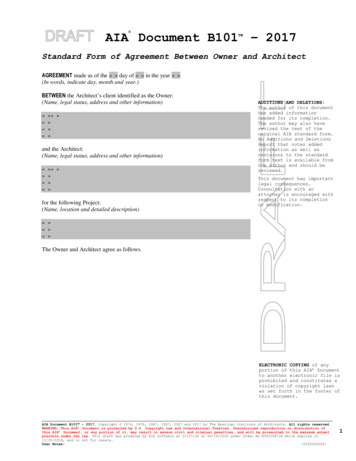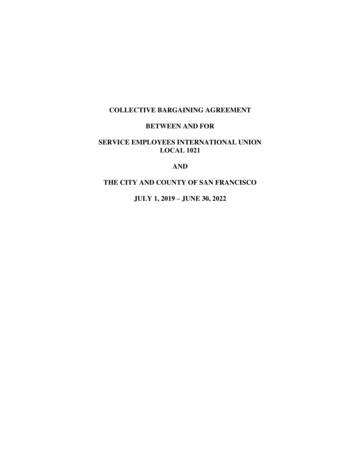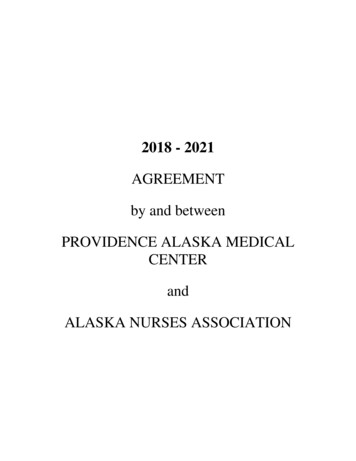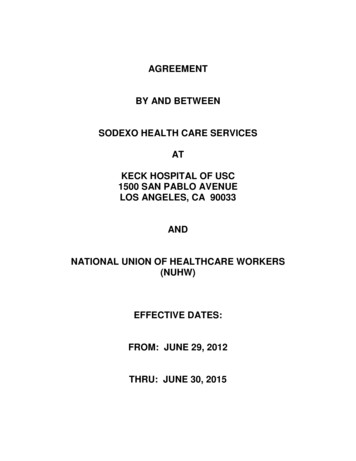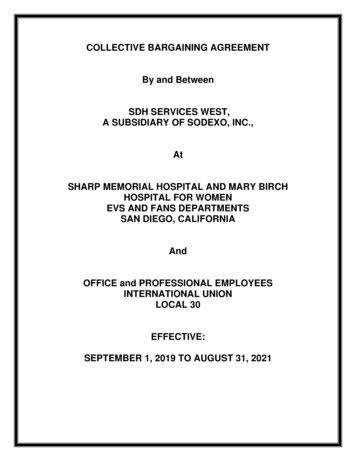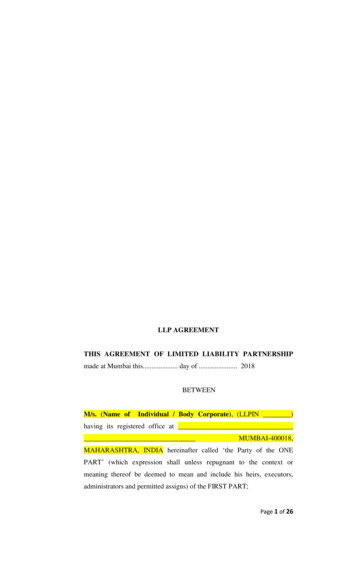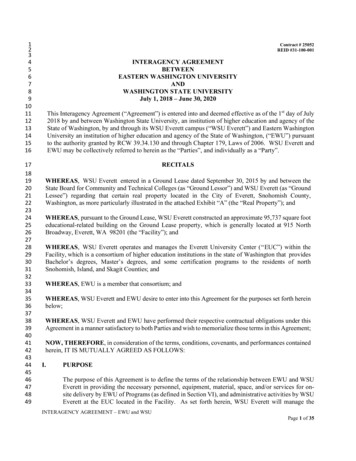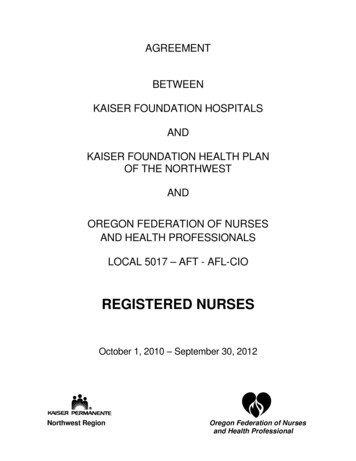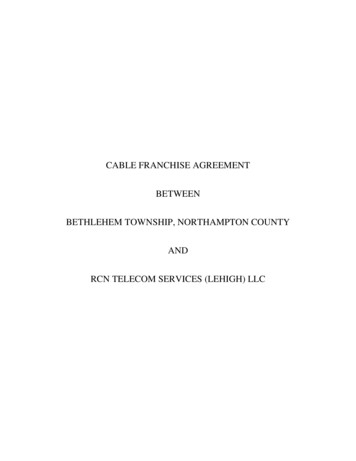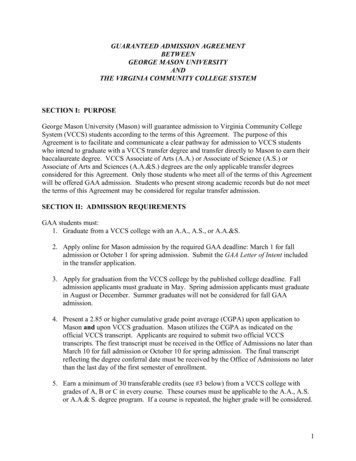
Transcription
AGREEMENT BETWEEN JAPAN AND THE REPUBLIC OF PERUFOR AN ECONOMIC PARTNERSHIPTable of ContentsPreambleChapter 1General ProvisionsArticle 1Establishment of a Free Trade AreaArticle 2Relation to Other AgreementsArticle 3Regional and Local GovernmentArticle 4General DefinitionsArticle 5TransparencyArticle 6Public Comment ProceduresArticle 7Confidential InformationArticle 8Review and AppealArticle 9Measures against CorruptionArticle 10General ExceptionsArticle 11Security ExceptionsArticle 12TaxationArticle 13Temporary Safeguard MeasuresArticle 14CommissionArticle 15Contact PointsArticle 16Implementing AgreementChapter 2Trade in GoodsSection 1General RulesArticle 17Scope of ApplicationArticle 18DefinitionsArticle 19Classification of GoodsArticle 20National TreatmentArticle 21Elimination or Reduction of Customs DutiesArticle 22Non-Tariff MeasuresArticle 23Import Licensing- 1 -
Article 24Administrative Fees and FormalitiesArticle 25Export Duties, Fees or Other ChargesArticle 26Customs ValuationArticle 27Agricultural Export SubsidiesArticle 28Price Band SystemSection 2Safeguard MeasuresArticle 29General ProvisionsArticle 30Bilateral Safeguard MeasuresArticle 31Conditions and LimitationsArticle 32Investigating ProceduresArticle 33Provisional Bilateral Safeguard MeasuresArticle 34NotificationArticle 35Consultations and CompensationArticle 36ReviewSection 3Other ProvisionsArticle 37Chapter 3Sub-Committee on Trade in GoodsRules of OriginArticle 38DefinitionsArticle 39Originating GoodsArticle 40Wholly Obtained GoodsArticle 41Qualifying Value ContentArticle 42Non-Qualifying OperationsArticle 43AccumulationArticle 44De MinimisArticle 45Unassembled or Disassembled GoodsArticle 46Fungible Goods or MaterialsArticle 47SetsArticle 48Accessories, Spare Parts and ToolsArticle 49Packaging Materials and Containers forRetail Sale- 2 -
Article 50Packing Materials and Containers forShipmentArticle 51Indirect MaterialsArticle 52Consignment CriteriaArticle 53Proofs of OriginArticle 54Certificate of OriginArticle 55Certificate of Origin IssuedRetrospectivelyArticle 56Issuance of a Duplicate Certificate ofOriginArticle 57Origin DeclarationArticle 58Approved ExporterArticle 59NotificationsArticle 60Claim for Preferential Tariff TreatmentArticle 61Obligations Related to ImportationsArticle 62Validity of Proof of OriginArticle 63Supporting DocumentsArticle 64Preservation of Documents and RecordsArticle 65Minor ErrorsArticle 66Verifications ProcessArticle 67PenaltiesArticle 68ConfidentialityArticle 69Sub-Committee on Rules of OriginArticle 70Operational ProceduresArticle 71MiscellaneousArticle 72Transitional Provisions for Goods inTransit or StorageChapter 4Customs Procedures and Trade FacilitationArticle 73Scope of ApplicationArticle 74ObjectivesArticle 75Definition- 3 -
Article 76TransparencyArticle 77Information and Communications TechnologyArticle 78Risk ManagementArticle 79Customs ClearanceArticle 80Separate and Expedited Customs Proceduresfor ShipmentArticle 81Advance RulingsArticle 82ReviewArticle 83Customs Cooperation and Exchange ofInformationArticle 84PenaltiesArticle 85Sub-Committee on Customs Procedures andTrade FacilitationChapter 5Sanitary and Phytosanitary MeasuresArticle 86Scope of ApplicationArticle 87Reaffirmation of Rights and ObligationsArticle 88Enquiry PointsArticle 89Sub-Committee on SPS MeasuresChapter 6Technical Regulations, Standards andConformity Assessment ProceduresArticle 90Scope of ApplicationArticle 91ObjectivesArticle 92DefinitionsArticle 93Reaffirmation of Rights and ObligationsArticle 94International StandardsArticle 95Technical RegulationsArticle 96Conformity AssessmentArticle 97TransparencyArticle 98Technical Cooperation- 4 -
Article 99Sub-Committee on Technical Regulations,Standards and Conformity AssessmentProceduresArticle 100Chapter 7Information ExchangeCross-Border Trade in ServicesArticle 101Scope of ApplicationArticle 102DefinitionsArticle 103SubsidiesArticle 104National TreatmentArticle 105Most-Favored-Nation TreatmentArticle 106Market AccessArticle 107Local PresenceArticle 108Non-Conforming MeasuresArticle 109NotificationArticle 110TransparencyArticle 111Domestic RegulationArticle 112RecognitionArticle 113Payments and TransfersArticle 114ImplementationArticle 115Denial of BenefitsChapter 8Telecommunications ServicesArticle 116Scope of ApplicationArticle 117DefinitionsArticle 118Access and UseArticle 119Number PortabilityArticle 120Competitive SafeguardsArticle 121Treatment by Major SuppliersArticle 122ResaleArticle 123InterconnectionArticle 124Provisioning and Pricing of Leased CircuitServices- 5 -
Article 125Independent Telecommunications RegulatoryBodyArticle 126Universal ServiceArticle 127Public Availability of Licensing CriteriaArticle 128Allocation and Use of Scarce ResourcesArticle 129TransparencyArticle 130Settlement of Telecommunications DisputesArticle 131Relation to International OrganizationsArticle 132Relationship to Other ChaptersChapter 9Entry and Temporary Stay of Nationals forBusiness PurposesArticle 133General PrinciplesArticle 134Scope of ApplicationArticle 135DefinitionsArticle 136Grant of Entry and Temporary StayArticle 137Provision of Information and Facilitationof ProcedureArticle 138Sub-Committee on Entry and Temporary Stayof Nationals for Business PurposesArticle 139CooperationArticle 140Dispute SettlementArticle 141Immigration MeasuresArticle 142TransparencyChapter 10Government ProcurementArticle 143Scope of ApplicationArticle 144DefinitionsArticle 145National Treatment and Non-DiscriminationArticle 146Rules of OriginArticle 147Valuation of ContractsArticle 148Prohibition of OffsetsArticle 149Technical Specifications- 6 -
Article 150Tendering ProceduresArticle 151Qualification of SuppliersArticle 152Notice of Intended ProcurementArticle 153Notice of Planned ProcurementArticle 154Time-Limits for TenderingArticle 155Tender DocumentationArticle 156Awarding of ContractsArticle 157Limited TenderingArticle 158Transparency of Procurement InformationArticle 159Challenge ProceduresArticle 160Use of Electronic Means in GovernmentProcurementArticle 161ExceptionsArticle 162Rectifications or ModificationsArticle 163Privatization of Procuring EntitiesArticle 164Denial of BenefitsArticle 165Further NegotiationArticle 166Sub-Committee on Government ProcurementChapter 11Intellectual Property RightsArticle 167General ProvisionsArticle 168National TreatmentArticle 169Most-Favored-Nation TreatmentArticle 170Streamlining and Harmonization ofProcedural MattersArticle 171Acquisition and Maintenance ofIntellectual Property RightsArticle 172TransparencyArticle 173Promotion of Public Awareness ConcerningProtection of Intellectual PropertyArticle 174PatentsArticle 175Industrial Designs- 7 -
Article 176TrademarksArticle 177Geographical IndicationsArticle 178Copyright and Related RightsArticle 179Protection of Undisclosed InformationArticle 180Unfair CompetitionArticle 181Enforcement – GeneralArticle 182Enforcement – Border MeasuresArticle 183Enforcement – Civil RemediesArticle 184Enforcement – Criminal RemediesArticle 185Internet Service ProvidersArticle 186CooperationArticle 187Sub-Committee on Intellectual PropertyRightsArticle 188Chapter 12Other ConsiderationsCompetitionArticle 189Anticompetitive ActivitiesArticle 190Cooperation on Controlling AnticompetitiveActivitiesArticle 191Non-DiscriminationArticle 192Procedural FairnessArticle 193TransparencyArticle 194Non-Application of Paragraph 1 of Article7Chapter 13Improvement of the Business EnvironmentArticle 195Basic PrinciplesArticle 196Sub-Committee on Improvement of theBusiness EnvironmentArticle 197Liaison OfficeArticle 198Consulting ForaArticle 199Implementation of the Decisions of theSub-Committee- 8 -
Chapter 14CooperationArticle 200Basic PrinciplesArticle 201Areas and Forms of CooperationArticle 202ImplementationArticle 203Sub-Committee on CooperationChapter 15Dispute SettlementArticle 204Scope of ApplicationArticle 205CooperationArticle 206Good Offices, Conciliation, or MediationArticle 207Choice of ForumArticle 208ConsultationsArticle 209Establishment of Arbitral TribunalsArticle 210Composition of the Arbitral TribunalArticle 211Qualifications of ArbitratorsArticle 212Functions of Arbitral TribunalsArticle 213Proceedings of the Arbitral TribunalArticle 214Information in the ProcedureArticle 215Consolidation of ProceedingsArticle 216Award of the Arbitral TribunalArticle 217Suspension and Termination of ProcedureArticle 218Implementation of the AwardArticle 219Non-Implementation – Suspension ofBenefitsChapter 16Final ProvisionsArticle 220Annexes, Appendices and NotesArticle 221Table of Contents and HeadingsArticle 222Entry into ForceArticle 223AmendmentsArticle 224TerminationArticle 225Authentic Texts- 9 -
Annex 1 referred to in Chapter 2Schedules in relationto Article 21Annex 2 referred to in Chapter 2Measures of Peru inrelation to Article 20and Article 22Annex 3 referred to in Chapter 3Product Specific RulesAnnex 4 referred to in Chapter 3Proofs of OriginAnnex 5 referred to in Chapter 7Annex 6 referred to in Chapter 7Annex 7 referred to in Chapter 7Financial ServicesAnnex 8 referred to in Chapter 9Specific Commitmentsfor Entry and TemporaryStay of Nationals forBusiness PurposesAnnex 9 referred to in Chapter 10Government ProcurementAnnex 10 referred to in Chapter 11 GeographicalIndications for Winesand Spirits- 10 -
PreambleJapan and the Republic of Peru (hereinafter referredto as “Peru”), hereinafter collectively referred to as the“Parties” and individually referred to as the “Party”:Committed to strengthen the longstanding friendshipand strong economic and political relations that havedeveloped through many years of mutually beneficialcooperation and growing trade and investment between theParties;Realizing that enhancing economic ties between theParties would contribute to increasing trade and investmentflows across the Pacific;Convinced that this Agreement would open a new era forthe relationship between the Parties;Recognizing that the economies of the Parties areendowed with conditions to complement each other and thatthis complementarity should contribute to further promotingsustainable economic development in the Parties, by makinguse of their respective economic strengths throughbilateral trade and investment activities;Believing that the implementation of this Agreementwill improve the living standards of peoples and create newand better employment opportunities in the Parties;Seeking to create a clearly established legalframework through mutually advantageous rules to governtrade, business and investment between the Parties, whichwould enhance the competitiveness of their economies,promote the economic relations between them, make theirmarkets more efficient and dynamic and ensure a predictablecommercial environment;Committed to avoid all distortions to their bilateraltrade;Further committed to develop effective mechanisms forcooperation in various fields as agreed in this Agreement;- 11 -
Recognizing the rights of the Parties to regulate inorder to meet national policy objectives pursuant tointernational agreements to which either Party is a partyand pursuant to this Agreement;Committed to implement this Agreement in a mannerconsistent with environmental protection and conservation;andReaffirming the importance of strengthening andenhancing the multilateral trading system as reflected bythe World Trade Organization (hereinafter referred to as“WTO”);HAVE AGREED as follows:- 12 -
Chapter 1General ProvisionsArticle 1Establishment of a Free Trade AreaThe Parties, consistent with Article XXIV of the GATT1994 and Article V of the GATS, hereby establish a freetrade area.Article 2Relation to Other Agreements1.The Parties reaffirm their rights and obligations withrespect to each other under the WTO Agreement or any otheragreement to which both Parties are parties.2.In the event of any inconsistency between thisAgreement and the WTO Agreement or any other agreement towhich both Parties are parties, the Parties shallimmediately consult with each other with a view to findinga mutually satisfactory solution, taking into considerationgeneral principles of international law.3.The provisions of the Agreement between Japan and theRepublic of Peru for the Promotion, Protection andLiberalisation of Investment, signed at Lima on November21, 2008 (hereinafter referred to as “BIT”), except itsArticles 24 (Joint Committee) and 25 (Sub-committee onImprovement of Investment Environment), as may be amended,are incorporated into and made part of this Agreement,mutatis mutandis.Note: In the event of any inconsistency between thisAgreement and the BIT, unless otherwise providedfor in this Agreement, the provisions ofparagraph 2 shall be applied.- 13 -
Article 3Regional and Local GovernmentIn fulfilling its obligations and commitments underthis Agreement, each Party shall take such reasonablemeasures as may be available to it to ensure theirobservance by regional and local governments andauthorities and non-governmental bodies in the exercise ofpowers delegated to them by central, regional and localgovernments or authorities within its Area. For greatercertainty, neither Party shall be discharged from itsobligations under this Agreement, in the event of a noncompliance with the provisions of this Agreement, by any ofits governmental levels or non-governmental bodies in theexercise of such powers delegated to them.Article 4General DefinitionsFor the purposes of this Agreement, unless otherwisespecified:(a)the term “Area” means:(i)(ii)with respect to Japan:(A)the territory of Japan; and(B)the exclusive economic zone and thecontinental shelf with respect to whichJapan exercises sovereign rights orjurisdiction in accordance withinternational law; andwith respect to Peru: the mainlandterritory, the islands, the maritime zones,and the air space above them, over whichPeru exercises sovereignty or sovereignrights and jurisdict
AGREEMENT BETWEEN JAPAN AND THE REPUBLIC OF PERU FOR AN ECONOMIC PARTNERSHIP Table of Contents Preamble Chapter 1 General Provisions Article 1 Establishment of a Free Trade Area Article 2 Relation to Other Agreements Article 3 Regional and Local Government Article 4 General Definitions Article 5 Transparency Article 6 Public Comment Procedures Article 7
